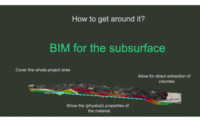The NBIMS-US V2 is not the only document designed to improve practice that was released or explained at the convention, which drew 18,600 registrants. Help designing energy misers is available in the form of the recently completed 50% Series of the Advanced Energy Design Guides (AEDGs), published by ASHRAE, in collaboration with the AIA, the Illuminating Engineering Society of North America and the U.S. Green Building Council.
AEDGs, funded by the U.S. Dept. of Energy, offer tools and recommendations for practical products and off-the-shelf technologies to aid in achieving a 50% energy savings compared to buildings that meet the minimum requirements of ANSI/ASHRAE/IESNA Standard 90.1-2004. The series includes a guide for hospitals, office buildings up to 100,000 sq ft, K-12 schools and medium to big "box" stores. The volumes are available for free download at ">www.ashrae.org/standards-research--technology/advanced-energy-design-guides.
The 50% Series goes beyond the original 30% Series, which was a cookbook for achieving 30% energy savings compared to buildings that meet the minimum requirements of ANSI/ASHRAE/IESNA Standard 90.1-1999.
"It was going to be difficult to achieve 50% without delving into other parts of the building," beyond heating and cooling systems and lighting, said Daniel H. Nall, senior vice president and director of sustainability for WSP Flack+Kurtz, New York City, and a member of the AEDGs committee. To achieve 50% savings, an integrated design process is needed, he added.
Designers need to consider the building's form, orientation, internal layout, the reflectance of interior finishes, exterior shading devices and electric-plug loads, he said.
As a result, the 50% Series offers both prescriptive and integrated design approaches because every building may not be able to comply with the prescriptive path, said Nall.
At the convention, the AIA released the AIA Guide to the ">International Green Construction Code. The 76-page document gives a summary of the development of energy codes and standards. It also offers guidance on the likely impacts on design and practice of the IgCC, if it is adopted by jurisdictions. It further provides a chapter-by-chapter summary of the International Code Council's IgCC, which is the first national green model code.
Described as an “overlay” code, the IgCC, when adopted by jurisdictions, would add green provisions on top of existing codes, such as the International Building Code (IBC), International Energy Conservation Code (IECC) and the other “I-Codes.”
"The IgCC is not news for those active in energy conservation," said Mary Ann Lazarus, the firm-wide director for sustainable design at HOK, St. Louis, and co-chairwoman of the AIA IgCC task force. "It is news that it may be codified."
The guide is intended for those who are not expert in energy modeling, added Norman Strong, a partner at the Miller Hull Partnership, Seattle, and Lazarus's co-chairman. At this point in time, the guide is available free to only AIA members. The AIA has not yet decided whether it will be offered to non-members.


Post a comment to this article
Report Abusive Comment